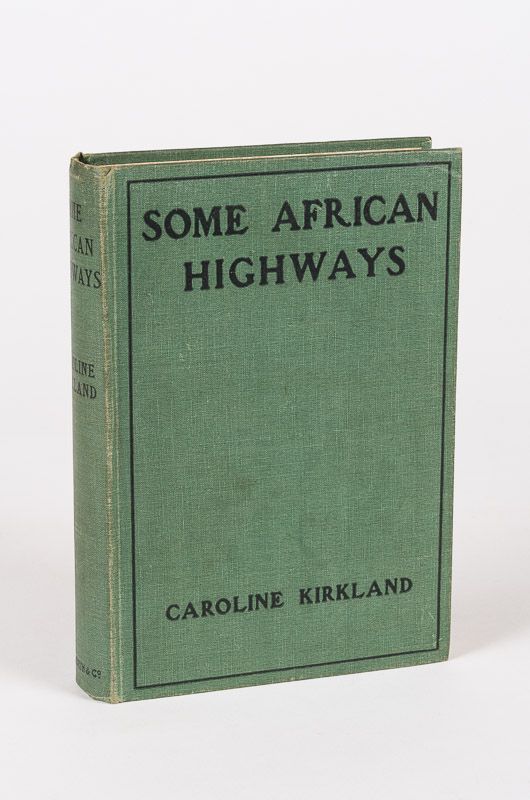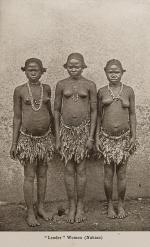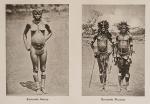Kirkland, Some African Highways. A Journey of Two American Women to Uganda and t
Some African Highways. A Journey of Two American Women to Uganda and the Transvaal. With Illustrations from Photographs and a Map. With an Introduction by Lieutenant-General Baden-Powell.
London, Duckworth & Co, 1908. 14.5 cm x 20.5 cm. Frontispiece, XVI, 345 pages. 46 illustrations. One fold-out map of Mombasa to Victoria (Railway) near front. Hardcover [publisher’s original green cloth] with lettering on spine and front board. Tooling to front board edges. Embossment to lower corner of rear board. Very good+ condition with only minor signs of external wear. Binding is solid and square. Interior is bright and clean with sharp corners. Preowner’s name on front endpaper.
Includes, for example, the following: Historical Sketch of East Africa and Uganda / From Naples to Mombasa / To Dar Es Salaam / From East to South Africa / Mozambique to Zanzibar etc. Photographs showing for example a dust storm in Commissioner Street, Johannesburg, Zanzibar Railroad – Train for Bu Bu Bu, Starting in front of the Sultan’s Palace at Zanzibar etc.
Introduction written by Lt. General R.S.S. Baden Powell, the popular hero of the Mafeking siege during the Boer War who went on to form the Boy Scouts. Powell writes: ‘How I should like to be a woman! It must be nice to lie back in your cushions and watch the men doing things which they think very clever, knowing all the time that you can do them very much better yourself if only you care to try…They [women] have a greater natural gift of observation and a most uncannily clever knack of “putting this and that together” and then deducing meaning from the smallest signs. Hence it comes that when women travel into the lesser-known countries of the world, as they frequently do nowadays, they bring this power of observation into play with remarkable results. And of all women in the world I would place our American cousins at the top of the list for this particular quality. Unfortunately it is only too seldom that they record their impressions, but when they do their pages ripple with little touches both quaint and human which are the direct result of quick observation and which paint the character of countries and people far more vividly than the more erudite writings of the mere man who plods along basing his remarks very largely on what he has already read or been told of the country now spread out before him.’ (p.ix-x)
Kirkland provides the modern reader with a rare glimpse of British rule in East Africa at the dawn of the 20th century that seems at once like the natural order of things but very tenuous and extraordinary at the same time:
’Wherever the English go they take the forms of life with them, so we found ourselves in a small gathering of well bred, well dressed people seated at a pretty table where flowers and shaded lights accompanied an excellent and most correctly ordered feast. Except for the barefooted, white-gowned and white-capped blacks, who glided noiselessly about, the occasion might have been at one of the centres of civilization. But the talk was of matters African…of the murder of Mr Galt by natives in Uganda; of the killings of another Englishman by an elephant, and the mangling of a third by a lion. By these tokens we knew we were in the Dark Continent. Also by a certain calm acceptance of fate. Those who have lived there some time get too used to the attacks of savage tribes and animals and strange African diseases to do more than comment in passing on the ill fortune of others. On must come to Africa to realize the blessing of the sense of personal security we enjoy in our occidental civilization.” (p.57)
Kirkland’s observations of the celebrations of King Edward VII’s at Government House at Entebbe is similarly infused with a sense of
mix of the foreign and the familiar – an intoxicating brew that fills her with wonder: ‘As I looked out in a pause of the evening through the vines that draped one end of the veranda, across a fragrant rose garden, to the tall trees of the Botanical Gardens and saw the stars grow in splendor as the glare of the dancing-room faded out of my eyes, I said to myself: “Can this be the equator? Is this what was short a time ago ‘Darkest Africa?’ Is that Victoria’s Nyanza?” Near at hand a gently bred lot of people were dancing to the tune of “Hiwatha.” Others were gambling mildly at bridge; still others were drinking the wines of France or Germany, and eating salmon from the Columbia River, caviar from Russia, fruits from India and any quantity of excellent edibles from Uganda.’ (p.121-22)
Elsewhere the author’s observations reveal implicit attitudes towards the natives: that their raison d’être is to be of service.
″Of one thing Africa is lavish, and that is human labor; willing, cheerful, obedient, and not unskillful, the black man makes tropical Africa possible to the white man. It needs, to be sure, about four of these native servants to do what one white servant would do in any other country. But when you consider that they are taken from naked, free savagery and thrust into clothes, routine and order, their services become a thing to wonder at.” (p.94)
- Keywords: Africa · Africa – Rare · Africa, British East · Africana Collection of Rare Books · British Dominions · British East Africa · Catalogue Three – Literature by Women · Colonialism · Railroad · Railroads · Railway · Railway Maps · Travel · Travel Africa – Rare · Travel Journal · Travel Writing · Travellers · Travelling Authors · Uganda · Women · Women Authors · Women in History – Rare · Women in Society · Women in Travel · Women Traveller · Women Traveller in Africa
- Language: English
- Inventory Number: 120181AB
EUR 130,--
© 2025 Inanna Rare Books Ltd. | Powered by HESCOM-Software














